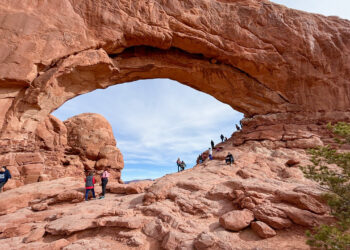By Holly Coltea GUEST COLUMNIST

This week, Big Sky was treated to one of nature’s rarest and most breathtaking performances—the northern lights dancing over us in red, green and purple. For me, it was a stop-in-your-tracks moment. We spilled out onto my friend’s porch; my daughter watched it from the Hummocks trailhead; and others stood shoulder to shoulder with their neighbors, quietly watching the sky come alive.
It was a reminder that when the sky is allowed to be a sky—dark, unpolluted and unobstructed—our little corner of Montana becomes truly extraordinary. That experience didn’t just happen by chance though. It happened because so much of our community has embraced the principles of dark-sky-compliant lighting. And if we want to keep enjoying night skies like this—auroras and shooting stars over Lone Mountain—we need to continue protecting the darkness that makes them visible.
Dark-sky lighting isn’t simply an aesthetic preference. Yes, it minimizes glare and helps wildlife follow natural patterns. Yes, it keeps neighborhoods from being washed out by excessive lighting. But the deeper purpose is something more meaningful: preserving our relationship with the night itself.
When we choose shielded fixtures that aim light down instead of up, select warmer bulbs instead of harsh blue-white LEDs, and use only the light we need—no more and no brighter—we are protecting a resource that is rare across the world: a truly dark sky. Here in Big Sky, darkness is part of our identity. It’s in our name. It’s part of our culture. It’s central to the Montana experience that we cherish. But our town is not immune to trends affecting other mountain towns, like rapid growth and commercial lighting creep. Once we lose darkness, it will be incredibly difficult to restore.
Last week’s aurora was a gift. Maybe it was also a gentle warning. If we want to keep seeing the sky above us as our parents and grandparents did—if we want our children to grow up knowing what a star-filled sky looks like—now is the time to recommit to responsible lighting choices at home, at businesses and across our community.
Protecting Big Sky’s night sky isn’t complicated. It starts with three simple steps:
First, use shielded, downward-directed fixtures that prevent light from spilling upward.
Second, choose warmer color temperatures (ideally 2700K or below).
Third, light only what you need and when you need it. Timers and motion sensors can help make that easy.
These small choices add up to something bigger, something we witnessed with absolute awe this week. So let’s keep our lights low and our stars sharp. Because when Big Sky stays dark, our night sky stays bright.
Holly Coltea is the executive director of the Big Sky Owners Association and the president of the Big Sky School District PTO. She is a business development strategist and entrepreneur with more than 20 years of experience driving growth and leading high-impact initiatives across the financial services, hospitality and consumer packaged goods industries. She is also deeply committed to community leadership, serving on boards and championing education and social impact efforts.














